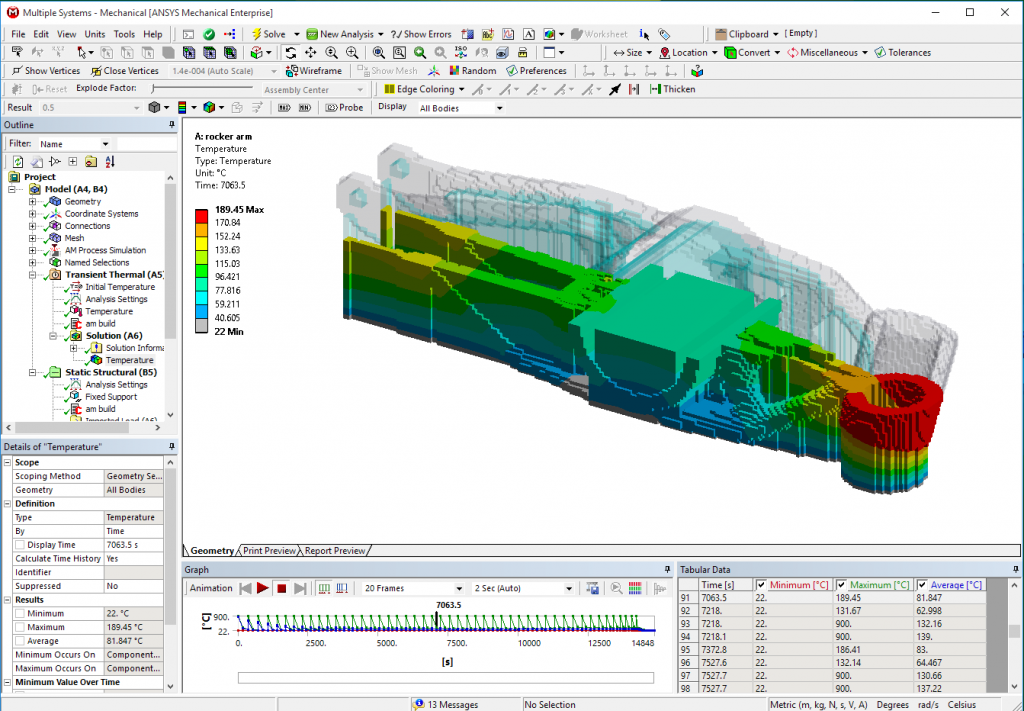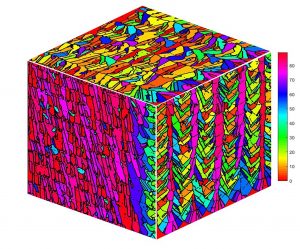
A Screenshot of ANSYS Mechanical Enterprise showing a part being analyzed.
ANSYS is the global leader in engineering simulation. We help the world’s most innovative companies deliver radically better products to their customers. By offering the best and broadest portfolio of engineering simulation software, we help them solve the most complex design challenges and engineer products limited only by imagination.
Just as with other markets, ANSYS offers the best and broadest portfolio of Additive Manufacturing Simulation Software in the industry. ANSYS provides the ability for AM designers to optimize their design, scientists to optimize materials, process engineers to optimize their process, analysts to analyze the geometry that will result from the build, and machine operators to avoid costly and time-consuming errors and problems all within a single suite of ANSYS software tools. ANSYS even provides quality assurance personnel data to compare predicted thermal profile to their own in-situ monitoring tools to accelerate the qualification process and lead to useful digital twins.
You should buy the ANSYS AM products because they will save you money, improve your products, increase your efficiency and save you time. The methods that ANSYS use to predict the behavior of a component during fabrication lead to the highest fidelity solution that a user can get on a part in a timeframe that allows useful data to be predicted. Organizations also have the ability to use universal tools for all of their groups to maintain consistency or they can utilize different approaches and tools all within the same applications for specialized and efficient utilization of the software. The flexibility, breadth, and level of high fidelity make buying ANSYS products a sure win.
As an engineer working in the Aerospace industry, my view was that simulation is absolutely necessary to move the AM Industry significantly forward in creating production level components. The standard process in the industry today is that there are many trial and error test iterations at every step of a product development cycle. Each of those steps can be drastically reduced through the use of simulation because a software user not only gets to see what the problems are, but they can also understand what is causing the problem. That allows the user the ability to identify the solution from the beginning. In addition, the user has the ability to try many iterations digitally, which does not require physical equipment. When failures are discovered, it does not require replacement of recoater blades and recalibration, etc. There are also many other aspects, such a machine maintenance, that are eliminated through digital iterations where a user does not need to clean out filters filled with titanium powder or store additional material just testing to make sure they can build a part successfully.

The displacement of a heat exchanger viewed in ANSYS Additive Print (Courtesy of Additive Industries)
Yes, a user can go through iterations of designing a part evaluating deformation, modifying the design and running the part again. However, the beauty of simulation is that the user does not need to go through as many iterations if they do not want to. In a single simulation cycle, users can determine distortion, stress, support optimization, timing and features that are causing problems and other information that would take several physical iterations to collect.
ANSYS allows users to do Agile Engineering in Additive Manufacturing by allowing Designers, Analysts, Researchers, Engineers and Operators to run digital iterations as frequently as they want to without the overhead of the full production cycle. A designer can create a design that they think may not require any support material and can then quickly simulate to determine if a support free design will result in recoater blade crashes or excessive distortion. They can then either utilize automatic tools to compensate for distortion or to automatically generate optimized support structures. The designer can run through many iteration cycles before they ever even need to work with a manufacturing group, which significantly streamlines this process. In addition to the process simulation, ANSYS offers the broadest engineering simulation software suite available, which can allow users to not only design for the manufacturing process, but also run Agile design iterations for performance in structural, fluids, electromagnetics and many many more fields to create not only an Additive Manufacturing solution, but a total product solution.
Yes, ANSYS is used today in the qualification of aviation hardware. As the Additive Manufacturing industry strives to move to more qualified aviation components, ANSYS’ Additive Manufacturing tools provide users with an ability unmatched by any other company to predict the full process at a sub-meltpool resolution, which allows users to understand how varying process parameters and geometric designs will impact a component’s ability to stay within specification parameters during the manufacturing process. ANSYS has the ability for a user to predict what is thermally happening within a part which users can use in conjunction with in-situ monitoring sensors to verify that a part is built as expected. In addition, ANSYS simulation provides the ability to see the temperature effects below the surface of a part whereas measurement sensors are generally only capable of seeing the surface of a part, which does not alway provide sufficient detail. All of this information provides users with data that is able to help raise confidence in the process and will allow aviation companies to deliver qualified components based on more generic specifications rather than costly point design or even material/machine specific specifications. Finally, simulation can drastically reduce the cost of developing specification limits, which will allow more aviation companies and suppliers to develop specifications and thereby generate more qualified components.

Microstructure visualization with ANSYS.
Due to the extremely high demand for DMLS components and the high level of errors that occur in the industry today, the primary focus of ANSYS tools is the DMLS process. However, the breadth of ANSYS Additive Suite tools also allows our customers the ability predict other processes, with still a more directed focus at other metal AM processes.
Generating the right supports in ANSYS is very easy: a user provides their desired design to the software via .stl format, the user utilizes an extremely easy to use interface to control any custom settings that they are interested in changing (including choosing their desired material and checking a box to run their simulation for supports). The software takes care of all slicing, meshing, support generation and etc. automatically, so a user will be provided a support structure file that is optimized based on the level of stress that the part will experience during the fabrication process at every specific point where a support interfaces with the part. A user can then take that support structure and utilize it for the fabrication of their part and the supports should not fracture. Predicting the part stress is essentially the same process, except instead of looking at the support structure that has been automatically optimized for stress the user will look at a 3D rendering of the datapoints at every mesh node within the part to easily visualize stress patterns, levels, and trends.
Additive Science enables you to improve your machine parameters by giving users the ability to digitally test many combinations of process parameters and evaluate ideal processing parameters for your specific machine and material. Many users are interested in building parts as rapidly as possible without running into processing problems, such as balling, porosity, blade crash, and other issues. Through utilizing the the output of the detailed Additive Science simulations for meltpool dimensions, and porosity calculations, users can determine the best process parameters as defined by the user.
The versatility and breadth of the ANSYS tools allows us to work closely with many different types of customers from Aerospace, to transportation, to energy, to consumer goods and from Large OEM organizations, to startup suppliers, including engineering firms and manufacturing facilities. We also work closely with machine and material vendors to provide joint customers the best solutions to their specific problems.
Metal Additive Manufacturing is an avenue to creating amazing products that will help to grow and improve your business as long as it is used for the appropriate applications. In the past the cost to entry for the “appropriate” applications has been so high that it significantly limited the number of entry points. A key to breaking down that barrier is to be more efficient. AM specific detailed simulations significantly reduce the cost barrier at every stage of the development cycle. In general companies take a lot of time and it costs them a lot of money to get started with metal AM. The training and education that comes from utilizing software accelerates the time to get up to speed with the industry; so leverage those tools that are available. You will save money, time, and employee stress by using simulation. The AM Suite from ANSYS is the only solution that combines engineering design tools, AM-specific tools for every part of your development chain, and validation support tools all in one product. So ANSYS is the obvious choice for AM simulation software.
Subscribe to Our Email Newsletter
Stay up-to-date on all the latest news from the 3D printing industry and receive information and offers from third party vendors.
You May Also Like
Profiling a Construction 3D Printing Pioneer: US Army Corps of Engineers’ Megan Kreiger
The world of construction 3D printing is still so new that the true experts can probably be counted on two hands. Among them is Megan Kreiger, Portfolio Manager of Additive...
US Army Corps of Engineers Taps Lincoln Electric & Eaton for Largest 3D Printed US Civil Works Part
The Soo Locks sit on the US-Canadian border, enabling maritime travel between Lake Superior and Lake Huron, from which ships can reach the rest of the Great Lakes. Crafts carrying...
Construction 3D Printing CEO Reflects on Being Female in Construction
Natalie Wadley, CEO of ChangeMaker3D, could hear the words of her daughter sitting next to her resounding in her head. “Mum, MUM, you’ve won!” Wadley had just won the prestigious...
1Print to Commercialize 3D Printed Coastal Resilience Solutions
1Print, a company that specializes in deploying additive construction (AC) for infrastructure projects, has entered an agreement with the University of Miami (UM) to accelerate commercialization of the SEAHIVE shoreline...





























